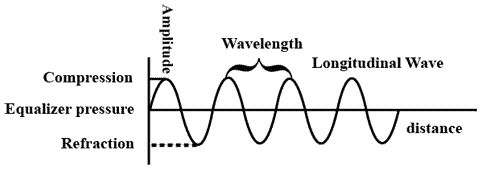Sound – 9th Class NCERT CBSE Science Chapter 12
Question: Can sound travel through:
- Carbon
- Water
Answer:
- yes
- yes
Question: Can sound travel through vacuum?
Answer: No, sound cannot travel through vacuum.
Question: Name the type of waves which are used by astronauts to communicate with one another on moon (or in outer space).
Answer: Radio Waves
Question: What type of wave is represented:
- By density-distance graph?
- By displacement-distance graph?
Answer:
- Longitudinal wave.
- Transverse wave
Question: In which medium sound travels faster: air or iron?
Answer: Iron (because it is a solid)
Question: What is the general name of the waves consisting of:
- Compression and rarefaction?
- Vests and troughs?
Answer:
- Longitudinal wave
- Transverse wave
Question: Is sound wave longitudinal or transverse?
Answer: Sound wave is longitudinal in nature.
Question: What is the relation between frequency (v) and time period of a sound wave?
Answer: v = 1/T
Frequency is inversely proportional to time period.
Question: In which of the three media air, water or steel does sound travel the fastest?
Answer: Sound travels fastest in steel.
Question: Which has a higher pitch – the sound of a whistle or that of a drum?
Answer: The sound of whistle has higher pitch.
Question: What is pitch?
Answer: The way our brain interprets the frequency of an emitted sound is called the pitch.
Question: How can we distinguish one sound from another having the same pitch and loudness?
Answer: The quality or timber of sound helps us to distinguish one sound from another having the same pitch and loudness.
Question: What is the audible range of frequency for human beings?
Answer: The audible range of frequencies for human beings is 20 Hz to 20,000 Hz.
Question: What is one Hz?
Answer: Hz is the unit of frequency, called as Hertz. One Hertz is equal to one cycle per second.
Question: Define speed of sound.
Answer: The speed of sound is defined as the distance travelled per unit time by compression or rarefaction.
Question: What is ‘note’ of sound?
Answer: The sound produced due to a mixture of several frequencies is called a note, it is pleasant to listen to.
Question: What is vacuum? Explain why, sound cannot travel through vacuum?
Answer: When there is no air in something, we say there is vacuum. Sound waves cannot travel through vacuum because vacuum has no molecules which can vibrate and and array sound waves from one place to another through their vibrations.
Question: Explain the term ‘amplitude of a wave’. Draw the diagram of a wave and mark its amplitude on it.
Answer: The maximum displacement of the particles of the medium from their original undisturbed positions, when a wave passes through the medium is called amplitude of the wave. The diagram is as following:

Question: Which of the following terms apply to sound wave in air and which to water waves? Transverse, Rarefaction, Trough, Crest, Compression, Longitudinal.
Answer: Sound waves in air:
- Longitudinal
- Rarefaction
- Compression
Water waves:
- Transverse
- Trough
- Crest
Question: (1). Name four in which sound can be produced.
(2). Calculate the speed of a sound waves whose frequency is 2 kHz and wave length 65 cm.
Answer: (1). Sound can be produced by following methods:
- By vibrating strings
- By vibrating air
- By vibrating membranes
- By vibrating plates
(2).
We have ⇒
65 cm = 65/100 m (λ)
2 kHz = 2000 Hz ( f)
and V = f × λ
= 2000 × 65/100
= 1300 m/s
Question: A wave is moving in air with a velocity of 340 m/s. Calculate the wavelength if its frequency is 512 vibrations/sec.
Answer:
Frequency ( f ) = 512 Hz
Velocity (V) = 340 m/s
λ = ?
V = f × λ
340 = 512 × λ
340/512 = λ
λ = 0.66 m
Question: Find the frequency of a wave whose time period is 0.002 second.
Answer:
Question: What is the time period-of sound wave?
Answer: The time taken by two consecutive compressions or rarefactions to cross a fixed points is called the time period of the wave.
Question: What name is given to those air crafts which fly at speeds greater than the speed of sound?
Answer: They are responsible for passing vibrations to the liquid in cochlea.
Question: What is the minimum distance required to hear distinct echo?
Answer: The minimum distance of the obstacle from the source of sound should be 17.2 m.
Question: What is reverberation?
Answer: The repeated reflection that results in the persistence of sound is called reverberation.
Question: What is SONAR?
Answer: SONAR is — Sound Navigation and Ranging. It is a device that uses ultrasonic waves to measure the distance, direction and speed of underwater objects by getting the reflection of sound.
Question: What is ‘ultrasonic’ and ‘infrasonic’ sound wave?
Answer: Sound waves with frequencies below the audible range (less than 20 Hz) are termed as “infrasonic” and those sound waves with frequencies above the audible range (more than 20000 Hz) are termed as “ultrasonic”.
Question: What should be the time interval between the originated sound and the reflected sound to be heard distinctly?
Answer: To hear a distinct sound the time interval between the originated sound and the reflected sound must be at least 0.1 secon
Question: What is a medium? Give two examples.
Answer: The matter or substance through which sound is transmitted is called a medium. It can be solid, liquid or gas. Example: air, water, metals.
Question: Define wave-motion.
Answer: A wave is a disturbance that moves through a medium when the particles of the medium set neighbouring particles into motion. The particles of the medium do not move forward but the disturbance is carried forward.
Question: What is ‘sonic boom’?
Answer: When an object just attains a supersonic speed, it causes shock waves in air. As a result there is large change in air pressure. This results in sonic boom.
Question: Why does sound become faint with distance?
Answer: Sound is a form of energy. As it moves away from the source its amplitude as well as its loudness decreases. The energy also get transformed in vibration of the particles of the medium.
 Class Notes NCERT Solutions for CBSE Students
Class Notes NCERT Solutions for CBSE Students






